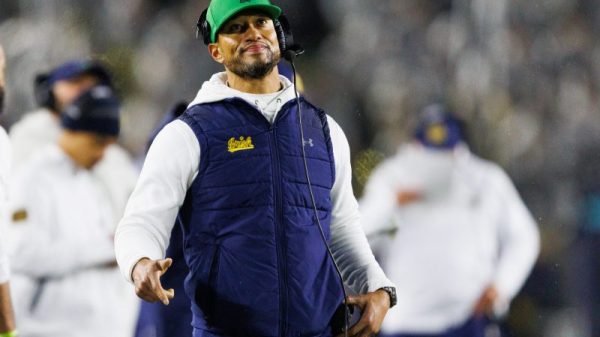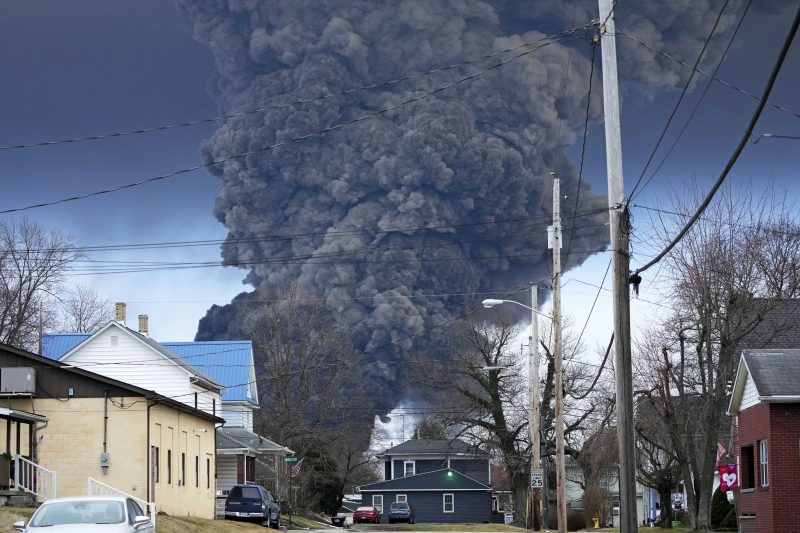There is no good news about the derailment of a train transporting hazardous chemicals in East Palestine, Ohio, earlier this month.
It is not good that the train derailed, regardless of contents, and it raises valid questions about safety and the extent to which the rail operator, Norfolk Southern, bears culpability for the accident. It is not good that toxic chemicals leaked from the train. It is not good that there may have been no other appropriate response to the disaster than to burn some of the chemicals being transported, with the functional effect of conducting a loosely controlled science experiment.
Let’s do away with the understatement, though. These things are not “not good”; they are actively bad. This is a huge disaster of unclear duration and effects without a silver lining.
But that uncertainty works the other way, too: This is not, at this point, obviously a disaster with necessarily dire long-term local, regional or national health consequences. It is not at this point obviously the case that burning the chemicals being carried by the train was not the appropriate response or one that exacerbated the effects.
It is not obviously the case, as one heavily quoted expert asserted to local news recently, that we “basically nuked a town with chemicals so we could get a railroad open.”
The past few decades have been rough ones for American institutions, from the presidency on down. But the past few years have been particularly rough for institutions that had otherwise held up fairly well: scientists and medical experts, particularly.
The advent of the coronavirus pandemic and the scrambling, chaotic effort to contain it inspired skepticism, both sincere and opportunistic. Are masks effective? Are they still effective? What about the vaccines? What about new variants? The answers were complex and evolving, characteristics that Americans have not proven eager to embrace. Elected leaders found it easier to set aside science in favor of politics — or even to villainize experts for political benefits.
So the East Palestine derailment taps into a remarkable number of potent, active strains of American skepticism. Can we really trust the train operator? The motivations of the people responding to the spill? The assurances of elected officials? Claims about the detected extent of the threat? Claims about its projected extent? The images coming out of eastern Ohio are apocalyptic but also cinematic, evoking any number of disaster movies in which authorities can’t be trusted and things end up worse than expected.
Doing better than your predecessor, is not doing enough.
The Biden administration needs to get more involved in this #PalestineOhio train derailment now.
We are counting on you to break the chain of administration after administration to turn a blind eye.
STEP UP NOW.
— Erin Brockovich (@ErinBrockovich) February 13, 2023
Chris Reddy is a senior scientist at the Woods Hole Oceanographic Institution in Massachusetts who studies chemical releases like the one in Ohio — though, importantly, he does not have firsthand knowledge about the East Palestine derailment. When we spoke by phone on Tuesday, his central argument was not that everything is better than it seems or worse than it seems. It was, instead, that it’s hard to know how good or bad things are now or will be in the future.
“This is so hard because there’s this mind-set in the world that you’re going to get an answer in four seconds with 100 percent certainty,” Reddy said of the uncertainty in the moment. “You have an ever-changing chemical series of reactions and releases and you just can’t see them. There’s no magic smartphone app that’s mapping it out.”
He emphasized the complexity of the situation. There were chemicals on the train. Some spilled; some — including, it seems, most of the vinyl chloride — didn’t. The extent of what was released is unclear. The decision to burn the vinyl chloride made the calculus more complicated still, given that, as Reddy put it, fire is “maybe a five or ten times possible magnifier in complexity.” You may recall this from high school science classes: Introduce heat to a chemical, and you can get a reaction that results in another chemical being created.
That said, this is not a controlled scientific experiment. Yes, fire plus vinyl chloride can, as The Washington Post reported last week, produce phosgene, an irritant used as a weapon in World War I, or hydrogen chloride. But it isn’t clear how much might be produced from this burn or where it might present itself. (The Environmental Protection Agency is monitoring the air in the region without “detect[ing] anything above the action level” per its update on Monday.) Uncertainty.
Reddy did offer one point of confidence.
“I’ve been working on environmental spills for the last 25 years, and as a whole, I’ve been always impressed with the local, state and federal response community,” he said. “I have great faith in these folks. These are not the bureaucrats. These are people who go to work every day and try to do a good thing.” Their mantra, he said, was, “How are we keeping a bad thing from getting worse?”
That is not to say that no errors might have been made, certainly, as Reddy himself was quick to note. Because of the complexity of the situation, it’s hard to even evaluate the state of play at the time decisions are being made. Measuring the amount of chemicals that have been released (or produced through the burn) might require a day or two to assess, by which time the situation has evolved further. A key question on which Reddy was focused was less whether those at the scene were making the right decisions but more whether the people making those decisions were qualified to do so.
Even with a quarter-century of experience, Reddy recognizes that even well-intentioned decision-makers might exacerbate rather than ameliorate problems. But, at this point, it’s not clear that this is what’s happened in East Palestine. There is no four-second, 100-percent-accurate assessment available.
While we await that complicated assessment, there is a demand for answers met in part (as Reddy put it) by “uncertainty and myth and misinformation.” There is a market for pithy assessments of the safety or risk of the scene and of the surrounding region, a market addressed, once again, by both good-faith concern and bad-faith opportunists. It’s a market with more customers thanks to the degradation in confidence that the experts actually know what they’re talking about, even when they might. Complexity doesn’t sell in the current information environment.
“This is not Chernobyl,” Reddy said of East Palestine. This is one of the few unnuanced pronouncements he felt comfortable making.



























